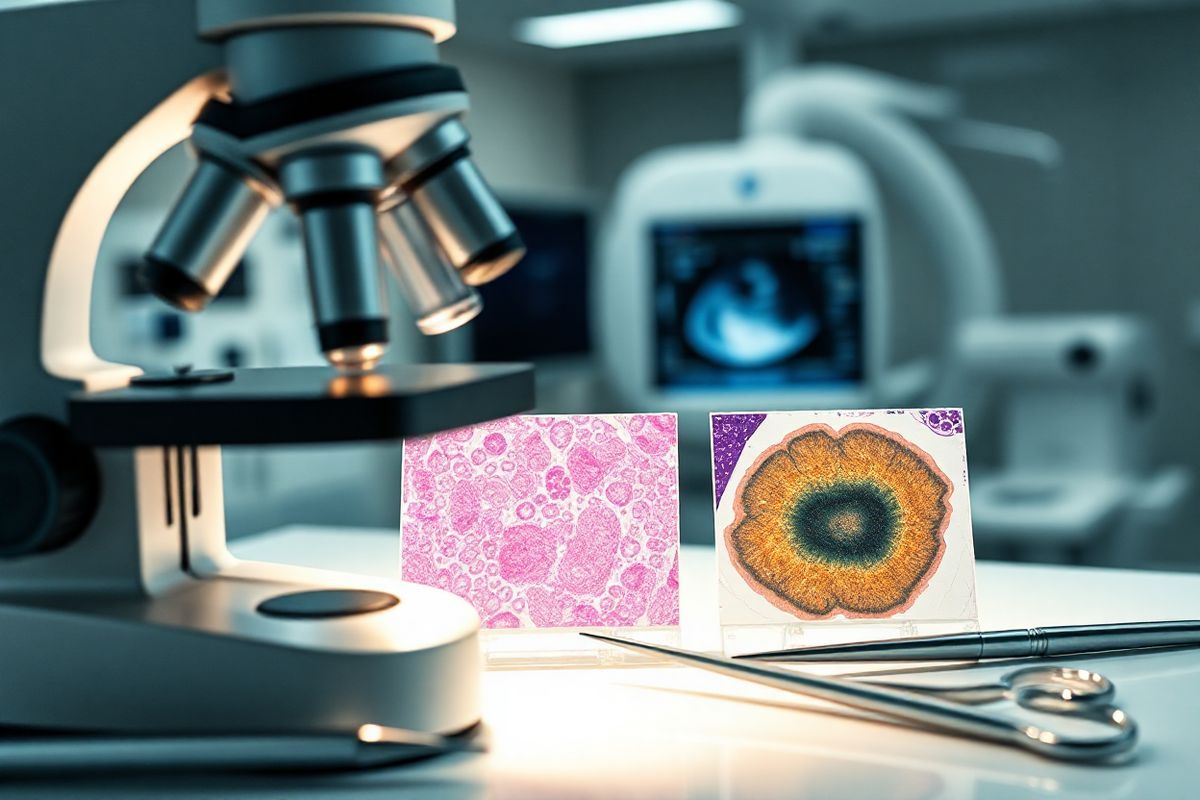Table of Contents
The Rise of Differentiated Thyroid Cancer: Trends and Insights

In recent years, differentiated thyroid cancer (DTC) has emerged as a significant public health concern, with its incidence steadily rising globally. This trend is particularly evident in papillary thyroid carcinoma (PTC), which has become the most prevalent form of endocrine malignancy, accounting for approximately 80% of all thyroid cancer cases (Haugen et al., 2016). The increasing detection rates of DTC can be attributed to advancements in diagnostic imaging techniques and heightened awareness among healthcare providers and patients alike. For instance, thyroid ultrasounds and fine needle aspiration biopsies are more frequently performed, leading to the identification of smaller and asymptomatic tumors that may have previously gone undiagnosed (Haugen et al., 2016).
While the prognosis for patients with DTC, especially classic variants, is generally favorable—with a 10-year survival rate exceeding 95%—the landscape is more complex when considering the aggressive subtypes of PTC, such as Hürthle cell carcinoma (HCC) and columnar cell variant (CCV) (Coca-Pelaz et al., 2024). These variants, although less common, are associated with poorer survival rates and higher rates of metastasis and recurrence (Coca-Pelaz et al., 2024). HCC represents about 3% to 4% of all thyroid cancer cases and is characterized by distinctive cellular features, including an abundance of oxyphilic granular cytoplasm (Haugen et al., 2016). Conversely, CCV, accounting for only 0.15% to 0.4% of PTC cases, exhibits aggressive behavior, impacting patients across a wide age range (Coca-Pelaz et al., 2024).
The rising trends in DTC incidence can be linked to various factors, including increased exposure to environmental risk factors such as radiation, genetic predispositions, and lifestyle changes. Ongoing research continues to investigate these associations, as understanding the underlying causes of this increase is crucial for developing effective prevention and treatment strategies.
Unpacking the Subtypes: A Closer Look at Papillary and Follicular Carcinomas

Differentiated thyroid cancers primarily comprise two major subtypes: papillary thyroid carcinoma (PTC) and follicular thyroid carcinoma (FTC). While PTC is characterized by its slow growth and excellent prognosis, FTC tends to exhibit more aggressive behavior, making distinctions between these subtypes essential for effective management (Haugen et al., 2016).
Papillary Thyroid Carcinoma (PTC)
PTC is the most common form of thyroid cancer and is known for its indolent nature. It often presents as a solitary nodule and can be multifocal in nature (Coca-Pelaz et al., 2024). Histologically, PTC is characterized by the presence of papillae lined by cuboidal or columnar epithelial cells, often with nuclear features such as grooves and inclusions that are indicative of malignancy (Haugen et al., 2016). The prognosis for PTC is generally favorable, with a 5-year survival rate of approximately 90% to 95% (Haugen et al., 2016).
However, certain variants of PTC, such as the tall cell variant and the widely invasive variant, are associated with more aggressive behavior and poorer outcomes. The treatment for PTC typically involves surgical intervention, usually a total or near-total thyroidectomy, followed by radioactive iodine therapy as needed (Haugen et al., 2016).
Follicular Thyroid Carcinoma (FTC)
FTC represents the second most common type of differentiated thyroid cancer, accounting for about 10% to 15% of cases. Unlike PTC, FTC typically arises from follicular cells and is characterized by encapsulated tumors with a potential for vascular invasion (Coca-Pelaz et al., 2024). The prognosis for FTC is less favorable compared to PTC, particularly when there is evidence of vascular invasion or distant metastasis at diagnosis. Treatment usually involves total thyroidectomy, with radioactive iodine treatment often recommended based on risk stratification (Haugen et al., 2016).
Table 1 summarizes the key differences between PTC and FTC, including their characteristics, treatment approaches, and prognosis.
| Feature | Papillary Thyroid Carcinoma | Follicular Thyroid Carcinoma |
|---|---|---|
| Incidence | 80% of thyroid cancers | 10%-15% of thyroid cancers |
| Origin | Follicular cells | Follicular cells |
| Growth pattern | Indolent, often multifocal | More aggressive, potential for vascular invasion |
| Prognosis | 90%-95% 5-year survival | Varied, worse if invasive |
| Treatment | Total thyroidectomy, RAI | Total thyroidectomy, RAI based on risk |
Diagnosis and Detection: Cutting-Edge Techniques for Accurate Identification
The diagnosis of differentiated thyroid cancer has evolved significantly over the last few decades, largely due to advancements in imaging technologies and diagnostic methodologies. The gold standard for diagnosing thyroid cancer involves a combination of clinical evaluation, imaging studies, and cytological analysis.
Imaging Techniques
Ultrasound is frequently the first line of imaging utilized in the evaluation of thyroid nodules. It is effective at characterizing nodules based on their size, composition (solid vs. cystic), and vascularity (Haugen et al., 2016). In cases where nodules exhibit suspicious characteristics, fine needle aspiration (FNA) is employed to obtain cytological samples for further evaluation. FNA is guided by ultrasound to enhance accuracy and minimize complications (Haugen et al., 2016).
Computed tomography (CT) and magnetic resonance imaging (MRI) are utilized in specific scenarios, particularly in assessing the extent of disease, planning surgical interventions, and evaluating potential metastases. The role of positron emission tomography (PET) is also emerging, particularly in cases of recurrent or advanced disease where traditional imaging may not provide sufficient detail (Coca-Pelaz et al., 2024).
Cytological Evaluation
The Bethesda System for Reporting Thyroid Cytopathology provides a standardized approach for interpreting FNA results, categorizing findings into six diagnostic categories ranging from benign to malignant (Coca-Pelaz et al., 2024). This system allows for more tailored management plans based on the cytological diagnosis, facilitating timely intervention for malignant cases.
Recent advancements in molecular diagnostics, including next-generation sequencing (NGS), offer the potential for identifying genetic mutations associated with specific thyroid cancers. This can provide valuable prognostic information and guide therapeutic decisions, particularly in cases of aggressive variants such as HCC (Haugen et al., 2016).
Treatment Strategies: From Surgery to Targeted Therapies
The management of differentiated thyroid cancer is multifaceted, involving surgical intervention, radioactive iodine therapy, and, in some cases, targeted therapies. The treatment approach is primarily dictated by the type of cancer, tumor size, and presence of metastasis.
Surgical Management
Surgery remains the cornerstone of treatment for differentiated thyroid cancer. Total thyroidectomy is typically recommended for larger tumors or those with aggressive features. Studies have shown that total thyroidectomy significantly reduces the risk of recurrence compared to lobectomy, especially in cases with higher-stage disease (Coca-Pelaz et al., 2024).
Radioactive Iodine Therapy
Radioactive iodine (RAI) therapy is commonly administered postoperatively for patients with well-differentiated thyroid cancer to eliminate residual thyroid tissue and reduce the risk of recurrence (Haugen et al., 2016). The effectiveness of RAI in improving overall survival rates remains a topic of debate, with some studies suggesting it provides a survival benefit, while others indicate limited impact, particularly in low-risk patients (Coca-Pelaz et al., 2024).
Targeted Therapies
In recent years, the landscape of treatment for differentiated thyroid cancer has expanded to include targeted therapies, especially for patients with advanced or refractory disease. Agents such as tyrosine kinase inhibitors (TKIs) have shown promise in managing aggressive thyroid cancers, including Hürthle cell carcinoma and anaplastic thyroid cancer. Clinical trials continue to explore the efficacy of these agents in improving outcomes for patients with advanced disease (Coca-Pelaz et al., 2024).
Prognosis and Survival: Understanding Outcomes for Patients with Differentiated Thyroid Cancer
The prognosis for patients with differentiated thyroid cancer is generally favorable, particularly for those diagnosed with classic PTC. However, specific factors can significantly influence survival outcomes.
Survival Rates
The 5-year survival rate for patients with PTC typically exceeds 90%, with long-term outcomes remaining robust for patients with localized disease (Coca-Pelaz et al., 2024). In contrast, patients with aggressive variants such as Hürthle cell carcinoma and columnar cell variant face higher risks of metastasis and recurrence, leading to lower survival rates. For example, HCC patients show a 5-year survival rate of approximately 97.5%, while CCV patients may experience a survival rate of only 90.6% (Coca-Pelaz et al., 2024).
Prognostic Factors
Factors influencing prognosis include age at diagnosis, tumor size, histological subtype, and presence of extrathyroidal extension or metastasis. Older age has been consistently associated with poorer outcomes, likely due to the increased likelihood of comorbidities and less aggressive treatment tolerability (Coca-Pelaz et al., 2024). Moreover, the presence of lymph node involvement at diagnosis is a significant adverse prognostic indicator, correlating with higher rates of recurrence and mortality (Haugen et al., 2016).
Importance of Follow-Up
Long-term follow-up is critical for patients with differentiated thyroid cancer, particularly those with high-risk features. Regular monitoring, including thyroglobulin levels and imaging studies, is essential for detecting recurrence early and implementing timely interventions (Coca-Pelaz et al., 2024).
Frequently Asked Questions (FAQ)
What is differentiated thyroid cancer?
Differentiated thyroid cancer (DTC) primarily includes papillary thyroid carcinoma (PTC) and follicular thyroid carcinoma (FTC), known for their unique histological features and generally favorable prognosis.
What are the common symptoms of DTC?
DTC often presents with a lump or nodule in the neck, difficulty swallowing, voice changes, and neck pain. However, many cases are asymptomatic and discovered incidentally.
How is DTC diagnosed?
Diagnosis typically involves ultrasound imaging, fine needle aspiration biopsy for cytological analysis, and sometimes molecular testing for genetic mutations.
What are the treatment options for DTC?
Treatment options include surgical intervention (total or partial thyroidectomy), radioactive iodine therapy, and targeted therapies for advanced disease.
What is the prognosis for patients with DTC?
The prognosis is generally favorable, with high survival rates, particularly for classic PTC. However, aggressive variants like Hürthle cell carcinoma may have a poorer prognosis.
References
-
Coca-Pelaz, A., et al. (2024). Prognostic Models Using Machine Learning Algorithms and Treatment Outcomes of Papillary Thyroid carcinoma Variants. Retrieved from https://pubmed.ncbi.nlm.nih.gov/11607134/
-
Haugen, B. R., et al. (2016). 2015 American Thyroid Association Management Guidelines for Adult Patients with Thyroid Nodules and Differentiated Thyroid Cancer: The American Thyroid Association Guidelines Task Force on Thyroid Nodules and Differentiated Thyroid Cancer. Thyroid, 26(1), 113-121. doi:10.1089/thy.2015.0020.
-
Pompili, M., et al. (2012). Prolactin and thyroid hormone levels are associated with suicide attempts in psychiatric patients. Psychiatry Research, 200(2-3), 389-394. doi:10.1016/j.psychres.2012.05.010.
-
Zhang, L., et al. (2021). Liquid biopsy in cancer: current status, challenges and future prospects. PLOS ONE, 10.1371/journal.pone.0311347. Retrieved from https://doi.org/10.1371/journal.pone.0311347
-
Fernandez-Camins, B., et al. (2023). Characterisation of type 2 diabetes subgroups at diagnosis: the COPERNICAN prospective observational cohort study protocol. BMJ Open, 13(3), e083825. doi:10.1136/bmjopen-2023-083825.
-
EFSA Panel on Food Enzymes (2024). Safety evaluation of the food enzyme containing endo‐polygalacturonase and β‐glucosidase from the non‐genetically modified Aspergillus tubingensis strain ARO. EFSA Journal, 22(12), e9125. doi:10.2903/j.efsa.2024.9125.
-
Mayo Clinic Staff. (2024). Hurthle cell cancer - Symptoms & causes - Mayo Clinic
-
Clinical Characteristics and Treatment Outcomes of Thyroid Cancer at a Tertiary Care Hospital in Najran Region, Saudi Arabia: A Single-Centre Retrospective Study. (2023). Cureus, 15(10), e72380. doi:10.7759/cureus.72380.










